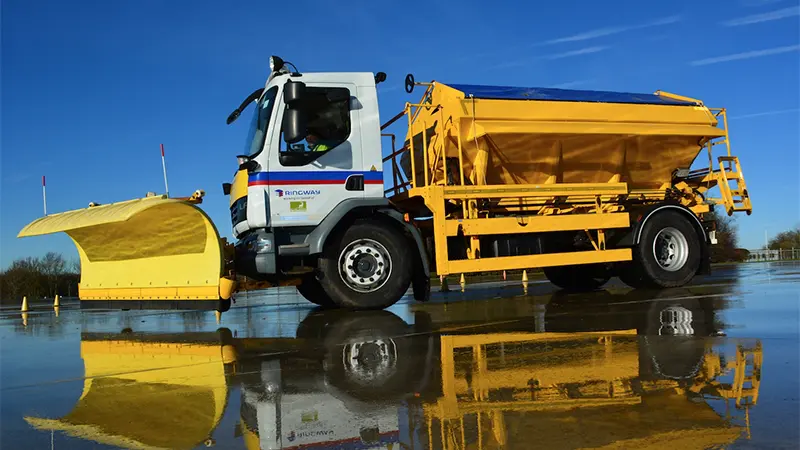

Fleet Size
280 LCVs (LCB Wales and West, original fleet)
750 LCVs in Cardo Group (including LCB)
Cardo Group is an asset management and construction maintenance company working within the social housing sector. Its team members strip, renovate, and maintain social housing properties.
Group Fleet Manager Sean Hewings originally overhauled road risk management at LCB Wales and West, a company which is now owned by Cardo Group, and Sean now hopes to replicate his success across the entire group.

Sean Hewings won the Fleet Risk Manager Award at the 2025 WhatVan? Awards sponsored by Driving for Better Business. Judges were impressed at how Sean improved legal compliance and driver behaviour resulting in a significant reduction in collisions and improved cost control.
Summary of Achievements
Vehicle Collisions
DOWN 70%
Driver Performance
UP 260%
Repair Costs
DOWN
Operational Costs
DOWN 5%
Demonstrating leadership in driver safety
“We want our drivers to get to work safely, do their jobs safely, and get home on time, promptly, to enjoy their family time. Collisions don’t just have ramifications for them and their families, but for other road users and all across the business. That’s why we are committed to reducing our road risk wherever possible across the whole group.”
Sean Hewings
Group Fleet Manager
More details

Declaration
“We want our drivers to get to work safely, do their jobs safely, and get home on time, promptly, to enjoy their family time. Collisions don’t just have ramifications for them and their families, but for other road users and all across the business. That’s why we are committed to reducing our road risk wherever possible across the whole group.”
Sean Hewings
Group Fleet Manager
Business Benefits
- Lifted driver performance from 33% above telematics grade C to 85% in five months
- In Q4 2024 collisions decreased by 70% year on year
- 84% reduction in collisions January 2024 vs January 2023
- Heavily reduced repair costs
- 5% cut in operational costs, such as fuel reduction, in 2024
The challenge
When Sean joined LCB (Wales and West) in September 2023 to manage its fleet, he discovered that there was no effective fleet management in place. Vans were typically kept at operatives’ homes, and there was no effective method for ensuring compliance. There was no data on fleet compliance and collisions were high. Data showed that accident ratio vs volume of drivers was at 25%, meaning a quarter of drivers were involved in a collision every year, and one vehicle was being written off each month – and insurance premiums leapt up by £150,000.
Improving Roadworthiness
Sean started by overhauling the vehicle maintenance schedule and ensuring that every LCV was properly serviced and had a compliant MOT. The company had been using a single local garage, so Sean switched to AA Prestige which has a nationwide network of 700 garages, to ensure good rates, quality, and availability.
“When I looked at the data on average, we were spending about £75 per hour on labour rates and over 100% plus mark up on parts. So, we negotiated better rates with AA Prestige network and have been able to manage our fleet costs,” he says.
He also negotiated nationwide coverage on tyres and windscreens.
Sean found that the company spent £100,000 annually repairing and maintaining the 25% of vans which were over five years old – more than it spent on all of its younger vehicles put together. Sean immediately replaced all vans over seven years old, and implemented a plan which would see the whole fleet transition to a five-year renewal schedule within two years. This improved the fleet’s roadworthiness and cut repair bills substantially, as well as reclaiming more money from residual values at disposal.
Driver behaviour and compliance
Sean’s next focus was driver compliance. He first ensured that every company driver had a valid licence, and hired a company to conduct regular driving licence checks.
He then instituted a driving for work policy.
The next area of focus was driver behaviour. While the company had Trakm8 telematics in the vehicles, no one had monitored the data, so Sean generated a report on all drivers rated between A (outstanding) and F (very poor).
This showed that almost all collisions involved drivers scoring below D, so his immediate plan was to improve driver performance to C and above across the fleet.
In April 2024 he initiated an internal driver improvement programme. Each month he spends time with the 10 worst scoring drivers on the fleet. He explains to them that driving is the most dangerous activity they undertake, and how they are subjecting themselves to high levels of risk through their driving behaviour. He also shows them the company’s real-world collisions, the vehicle damage they had suffered and the insurance and cost implications. Each driver is shown their own high-risk habits, followed by a group discussion about how they can each improve.
Sean monitors their improvement over eight weeks sending the drivers weekly scores and feedback, and most drivers improve quickly and consistently. Occasionally however, he has had to let a driver go who continues to drive recklessly despite the training.
Before the driver improvement programme began only 34% of LCB’s drivers were at a C or above grade; after five months, 86% of drivers were performing at C or above – an increase of 260%
“Some drivers improved the moment they read the email saying they were being asked to come in for driver training. In other words, they knew they were speeding or taking risks, and as soon as they knew they were being monitored, they self-regulated even before any education from us,” he says.
“Others needed time and continual prompting over three or four weeks before their driving consistently improved. That’s the pattern each time – some drivers immediately improve, and others need time and coaching to develop better habits.”
His key message? “Drive as though you have a full glass of water in your van and you must not spill it.”
The company’s insurer provided a £10,000 bursary to fit forward facing cameras across the fleet. Sean negotiated with telematics provider Trakm8 to fit its integrated camera solution across the fleet. The cameras not only record on-road events but they also flash traffic light warnings at drivers, with amber and red alerting them to risky driving in real time.
Once the camera roll-out is complete, the drivers will be given an app on which they can see their more detailed telematics and behaviours scores. Sean believes this combination of real time alerts, personalised telematics data and management coaching will keep his drivers on a path of continuous improvement.
The future
Having won the WhatVan? Fleet Risk Manager Award in 2024 for his work with LCB’s fleet, Sean has now been asked to replicated his work across the entire Cardo Group fleet of over 700 LCVs.
The fleet is not only larger, it is also now nationwide and remote driver management brings its own challenges.
While Sean is recruiting line and regional managers to support him in road-risk messaging, he intends to deliver the driver education directly by the fleet team, even if they travel regionally to do it.
“You have to really understand the road risk piece and have that passion for it, to help drivers create the change we want,” he says.
“It will be challenging for the Cardo drivers, because we’re going to be enforcing change on them and watching their driving, which has not previously been monitored. The crucial thing is why we are doing it – yes, it saves the business money but first and foremost, their safety is paramount.”






